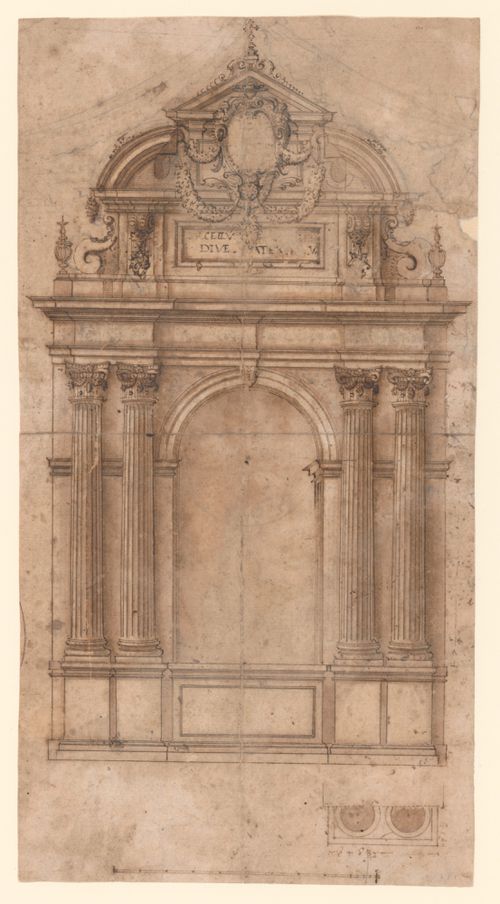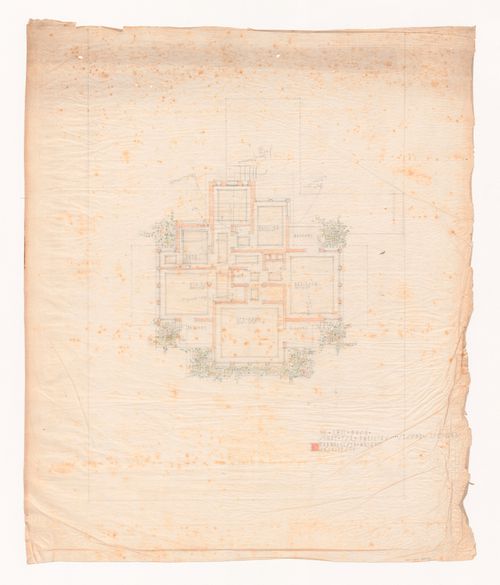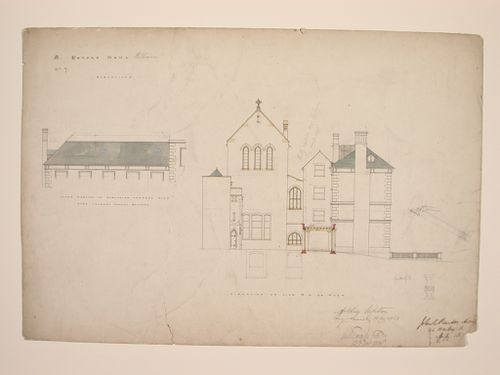dessins
Quantité:
3 drawing(s)
DR2007:0014:001-003
Description:
Colour-pencil drawing of plan of first floor (some minor damage), approx. 16" x 22"; small scale model of the first floor and partial second floor, approx. 8" x 14" x 10" on circular base. This project was realized and published in Larry Richards Works, 1977-1980 (Tech-Press, Halifax, 1980, pp. 8-13; ISB 0-920692-8).
1977-1978
President's House, Nova Scotia Technical College, Halifax, 1977-1978
Actions:
DR2007:0014:001-003
Description:
Colour-pencil drawing of plan of first floor (some minor damage), approx. 16" x 22"; small scale model of the first floor and partial second floor, approx. 8" x 14" x 10" on circular base. This project was realized and published in Larry Richards Works, 1977-1980 (Tech-Press, Halifax, 1980, pp. 8-13; ISB 0-920692-8).
dessins
Quantité:
3 drawing(s)
1977-1978
Projet
AP164.S1.2004.D3
Description:
The project series documents the masterplan of territorial organization of the Costa del Sol, in Spain, for the account of the Secretaría General de Ordenación del Territorio y Urbanismo and the Consejeria de obras publicas y transportes of the governement of Andalucia. The firm identified this project as number 181. "Our purpose is to convert the Costa del Sol in an authentic contemporary metacity, to put it on the map of Europe's principal cities and to organize an individual and [the] unstoppable development of each municipality into a wider framework that allows the integration of infrastructures through ecological-technical corridors demanded for a metropolitan scale. It also states the authentic urban value in addition to the local natural one." (ARCH270975) Abalos & Herreros worked with Jose Seguí, Jose Maria Ezquiaga (?) and Salvador Rueda Documenting the project are conceptual, design development and presentation drawings, cartographic, photographic and reference materials, correspondence, notes and presentation documents.
2003-2005
Plan de ordenación territorial, Costa del Sol, Spain (2004)
Actions:
AP164.S1.2004.D3
Description:
The project series documents the masterplan of territorial organization of the Costa del Sol, in Spain, for the account of the Secretaría General de Ordenación del Territorio y Urbanismo and the Consejeria de obras publicas y transportes of the governement of Andalucia. The firm identified this project as number 181. "Our purpose is to convert the Costa del Sol in an authentic contemporary metacity, to put it on the map of Europe's principal cities and to organize an individual and [the] unstoppable development of each municipality into a wider framework that allows the integration of infrastructures through ecological-technical corridors demanded for a metropolitan scale. It also states the authentic urban value in addition to the local natural one." (ARCH270975) Abalos & Herreros worked with Jose Seguí, Jose Maria Ezquiaga (?) and Salvador Rueda Documenting the project are conceptual, design development and presentation drawings, cartographic, photographic and reference materials, correspondence, notes and presentation documents.
Project
2003-2005
DR1969:0016
Description:
- This drawing represents an altar, perhaps a shallow side altar of a type increasingly demanded by the Counter-Reformation cult of saints. The dimensions of the rectangular form between the column pedestals (6 x 3 3/4 piedi, according to scale) are appropriate for an altar table. Freehand perspective on the inside right face of the arch indicates the shallowness of the niche, most likely meant to contain a devotional image in the form of a panel painting. A plan of one pair of the engaged columns figures on the lower right. The cardinal's hat signals a religious patron whose coat of arms once appeared in the now badly- abraded centre of the cartouche.
design d'intérieur
16th century
Design for an altarpiece frame
Actions:
DR1969:0016
Description:
- This drawing represents an altar, perhaps a shallow side altar of a type increasingly demanded by the Counter-Reformation cult of saints. The dimensions of the rectangular form between the column pedestals (6 x 3 3/4 piedi, according to scale) are appropriate for an altar table. Freehand perspective on the inside right face of the arch indicates the shallowness of the niche, most likely meant to contain a devotional image in the form of a panel painting. A plan of one pair of the engaged columns figures on the lower right. The cardinal's hat signals a religious patron whose coat of arms once appeared in the now badly- abraded centre of the cartouche.
design d'intérieur
Chèques Postaux - 1930
PH1986:0900.09
Description:
Album PH1986:0900.09 comprises 119 photographs of a post-office located on the Rue d'Alleray, Rue des Favorites and Rue Bourseul, Paris, France, designed by Michel Roux-Spitz. The building featured in the album is identified on one of the photographs as "Poste télégraphe - Téléphone - Bureau central du XVe arrondissement". Photographs show exterior and interior views of the post-office including the inner court, roof, several views of a scale model of the building, the post-office counter, set of shelves (the stacks), hallways, staircase, kitchen, cafeteria, boiler room, utility room and views of the post office's surroundings.
architecture, design d'intérieur
1930
Chèques Postaux - 1930
Actions:
PH1986:0900.09
Description:
Album PH1986:0900.09 comprises 119 photographs of a post-office located on the Rue d'Alleray, Rue des Favorites and Rue Bourseul, Paris, France, designed by Michel Roux-Spitz. The building featured in the album is identified on one of the photographs as "Poste télégraphe - Téléphone - Bureau central du XVe arrondissement". Photographs show exterior and interior views of the post-office including the inner court, roof, several views of a scale model of the building, the post-office counter, set of shelves (the stacks), hallways, staircase, kitchen, cafeteria, boiler room, utility room and views of the post office's surroundings.
1930
architecture, design d'intérieur
archives
Niveau de description archivistique:
Fonds
AP194
Résumé:
The Johan Bettum OCEAN North projects records, 1995-2000, consist of born-digital files and a physical drawing that document three projects by the OCEAN North collective: Synthetic Landscape (1995-2000), Jyväskylä Music and Arts Centre (competition, 1997), and Tölöö Football Stadium (competition, 1997). The archive also includes a small amount of additional born-digital reference materials on 11 projects from the collective, including the three projects mentioned above.
1995-2000
Documents d’archives de Johan Bettum pour les projets de OCEAN North
Actions:
AP194
Résumé:
The Johan Bettum OCEAN North projects records, 1995-2000, consist of born-digital files and a physical drawing that document three projects by the OCEAN North collective: Synthetic Landscape (1995-2000), Jyväskylä Music and Arts Centre (competition, 1997), and Tölöö Football Stadium (competition, 1997). The archive also includes a small amount of additional born-digital reference materials on 11 projects from the collective, including the three projects mentioned above.
archives
Niveau de description archivistique:
Fonds
1995-2000
DR1980:0060:003
Description:
- This plan, with the perspective (DR1980:0060:001) and the first floor plan (DR1980:0060:002), forms a set of early presentation drawings. The scale is probably 1/4" = 1' (see object file, de Long report). Comparing this drawing with the plan reproduced in Hitchcock, an additional staircase leading to a (here non-existent) terrace has been added behind the stairwell. The closet for the right bedroom has been changed, and the bathroom "nook" has been assigned to the left bedroom in the Hitchcock plan. Doors do not yet appear.
architecture
1915
Second floor plan for Emil Bach House, Chicago, Illinois
Actions:
DR1980:0060:003
Description:
- This plan, with the perspective (DR1980:0060:001) and the first floor plan (DR1980:0060:002), forms a set of early presentation drawings. The scale is probably 1/4" = 1' (see object file, de Long report). Comparing this drawing with the plan reproduced in Hitchcock, an additional staircase leading to a (here non-existent) terrace has been added behind the stairwell. The closet for the right bedroom has been changed, and the bathroom "nook" has been assigned to the left bedroom in the Hitchcock plan. Doors do not yet appear.
architecture
Projet
AP164.S1.2002.D16
Description:
The project series documents the competition entry for the development of the International fair of the South, in the municipality of Getafe, Spain. The firm identified this project as number 159a. “The project puts the emphasis on two esencial [sic] questions: on the one hand a system which allows to resolve the fair’s pavillons simple and elegantly joining criteria of light, structure and water in a system of constructive rationality and average economy. On the other han[d a]n organization of the public and constructed space in phases which allow to understand the technology area of the south as something complete and shaped since the first of them has been developed. The proposed exhibition pavillions [sic] come from a technical reasoning based in the balance of structural width, central light and drainage of the roof, a result of several projects of similar scale which the office has developed in the last years.” (ARCH270975) Abalos & Herreros initially grouped this project with the competition Fira 2000 - Barcelona (AP164.S1.2002.D14). Documenting the project are presentation drawings, project descriptions, correspondence, studies, competition documents and specifications.
circa 2002-2003
Fisur-Getafe (Concurso), Getafe, Spain (2002)
Actions:
AP164.S1.2002.D16
Description:
The project series documents the competition entry for the development of the International fair of the South, in the municipality of Getafe, Spain. The firm identified this project as number 159a. “The project puts the emphasis on two esencial [sic] questions: on the one hand a system which allows to resolve the fair’s pavillons simple and elegantly joining criteria of light, structure and water in a system of constructive rationality and average economy. On the other han[d a]n organization of the public and constructed space in phases which allow to understand the technology area of the south as something complete and shaped since the first of them has been developed. The proposed exhibition pavillions [sic] come from a technical reasoning based in the balance of structural width, central light and drainage of the roof, a result of several projects of similar scale which the office has developed in the last years.” (ARCH270975) Abalos & Herreros initially grouped this project with the competition Fira 2000 - Barcelona (AP164.S1.2002.D14). Documenting the project are presentation drawings, project descriptions, correspondence, studies, competition documents and specifications.
Project
circa 2002-2003
Projet
AP164.S1.2003.D10
Description:
The project series documents the commission and built project for an urban development and a public park on the banks of the rivers Torio and Bernesca in the area of La Lastra, León, Spain. The firm identified the project as number 173. “The park of La Lastra is composed by the superpositioning [sic] of four different states of natural space: a fluvial park, an urban park, an agricultural park and a park with common installations. Being next to the urbanization of La Lastra, both public spaces, both adopt a minimum strategy of landscape bubbles and urbanized bubbles respectively in the way that the whole complex becomes a continuum and achieves a scale able to diffuse the traditional limits of either urban fabric or park, confirming a singular complex which responds to the way in which new generations can understand the relation between nature and artificial.” (ARCH270975) Two other projects are related to this one: Alcorque para León (AP164.S1.2004.D5) and Puentes de León (AP164.S1.2004.D6). Documenting the project are presentation documents, notes, a dummy and a proposal.
circa 2003-2004
Urbanización del sector La Lastra, León, Spain (2003)
Actions:
AP164.S1.2003.D10
Description:
The project series documents the commission and built project for an urban development and a public park on the banks of the rivers Torio and Bernesca in the area of La Lastra, León, Spain. The firm identified the project as number 173. “The park of La Lastra is composed by the superpositioning [sic] of four different states of natural space: a fluvial park, an urban park, an agricultural park and a park with common installations. Being next to the urbanization of La Lastra, both public spaces, both adopt a minimum strategy of landscape bubbles and urbanized bubbles respectively in the way that the whole complex becomes a continuum and achieves a scale able to diffuse the traditional limits of either urban fabric or park, confirming a singular complex which responds to the way in which new generations can understand the relation between nature and artificial.” (ARCH270975) Two other projects are related to this one: Alcorque para León (AP164.S1.2004.D5) and Puentes de León (AP164.S1.2004.D6). Documenting the project are presentation documents, notes, a dummy and a proposal.
Project
circa 2003-2004
archives
Niveau de description archivistique:
Fonds
Gianni Pettena fonds
AP207
Résumé:
The Gianni Pettena fonds documents Pettena’s work as an artist, architect, critic, and professor of history of contemporary architecture from the 1960s to the end of the 2010s. It includes one hundred artistic and architectural projects, material related to exhibitions he curated and designed, and his writings.
1960-2019
Gianni Pettena fonds
Actions:
AP207
Résumé:
The Gianni Pettena fonds documents Pettena’s work as an artist, architect, critic, and professor of history of contemporary architecture from the 1960s to the end of the 2010s. It includes one hundred artistic and architectural projects, material related to exhibitions he curated and designed, and his writings.
archives
Niveau de description archivistique:
Fonds
1960-2019
DR1989:0015:002
Description:
- Ground plan for the contract drawings DR1989:0015:001 and DR1989:0015:003 - DR1989:0015:009,. Both the scale used in all nine drawings (1¼" = 10') and the section lines corresponding to the sections DR1989:0015:005 and DR1989:0015:007 - DR1989:0015:009, appear on this drawing. - This drawing is part of a group of drawings for St. Peter's Home, Kilburn, from the office of John Loughborough Pearson, composed of nine orthographic contract drawings dated 1867-1868 (DR1989:0015:001 - DR1989:0015:009) and one elevation for an addition in 1878 (DR1989:0015:010). These drawings were sold at auction by St. Peter's Convent, Woking, along with drawings for that institution (DR1989:0015:011 - DR1989:0015:089 R/V). Both institutions were commissioned from John Loughborough Pearson by Benjamin Lancaster. The alterations to the Home at Kilburn were commissioned on behalf of Lancaster's wife, who founded the home and the lay nursing order which ran it. Woking was founded by Lancaster as a home for incurables in 1882, and dedicated to the memory of his deceased wife (Quiney 67-68, 254-255, and 284). It was probably first known as St. Peter's Home, Woking, not becoming a convent until ca. 1934.
architecture
1867-1868
St. Peter's Home, Kilburn: Ground plan
Actions:
DR1989:0015:002
Description:
- Ground plan for the contract drawings DR1989:0015:001 and DR1989:0015:003 - DR1989:0015:009,. Both the scale used in all nine drawings (1¼" = 10') and the section lines corresponding to the sections DR1989:0015:005 and DR1989:0015:007 - DR1989:0015:009, appear on this drawing. - This drawing is part of a group of drawings for St. Peter's Home, Kilburn, from the office of John Loughborough Pearson, composed of nine orthographic contract drawings dated 1867-1868 (DR1989:0015:001 - DR1989:0015:009) and one elevation for an addition in 1878 (DR1989:0015:010). These drawings were sold at auction by St. Peter's Convent, Woking, along with drawings for that institution (DR1989:0015:011 - DR1989:0015:089 R/V). Both institutions were commissioned from John Loughborough Pearson by Benjamin Lancaster. The alterations to the Home at Kilburn were commissioned on behalf of Lancaster's wife, who founded the home and the lay nursing order which ran it. Woking was founded by Lancaster as a home for incurables in 1882, and dedicated to the memory of his deceased wife (Quiney 67-68, 254-255, and 284). It was probably first known as St. Peter's Home, Woking, not becoming a convent until ca. 1934.
architecture


